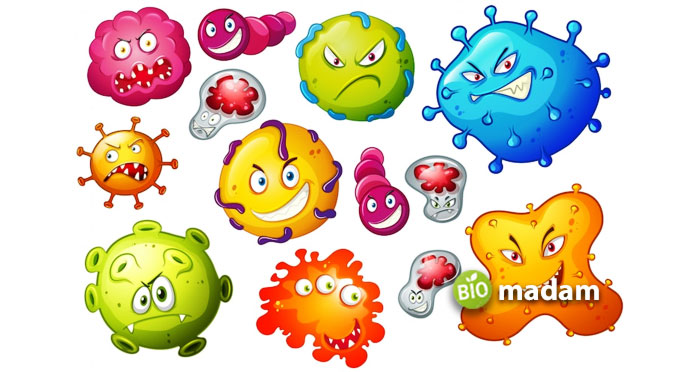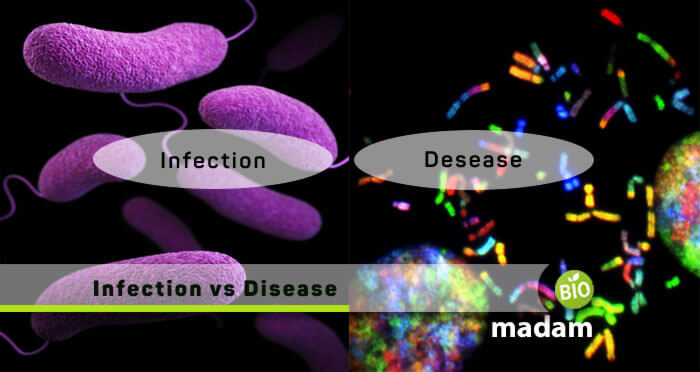You might be wondering how infection and disease differ from each other when both are actually diseases or conditions, cause issues inside the body.
The article has been written to guide you on how infection and disease differ from each other. Although both have similar reasons for occurrence and share the same passage still, the two vary in application and meaning. Infection refers to the process where microorganisms enter the body and can cause disease. The infection weakens the immunity and starts harming the body, which is termed a disease. The body’s immune system including innate and adaptive immunity fights the infective organism to protect you.
We have explained infection and disease in detail along with the comparison table to help you visualize how they are different from each other.
Comparison Table
| Characteristics | Infection | Disease |
| Transmissibility | Contagious | Contagious or non-contagious |
| Causes | Pathogens | Injury, infection, hereditary, lifestyle, etc. |
| Treatment | Drugs and surgery | Medicines, operations, and healthy lifestyle |
| Symptoms | Pain, fever, cough, runny nose, etc | Nausea, vomiting, breathing issues, etc. |
| Examples | UTI, eye infection, etc | Asthma, bronchitis, cancer, diabetes, etc. |
What is Infection?
Infection refers to the process when a bacteria, virus, fungus, or any other pathogen enters and multiplies inside the body. As result, the pathogen starts harming different parts of the body.
Infection can happen anywhere inside the body, from the skin to the respiratory and digestive tract. There are different symptoms of infection depending upon the type of pathogen and the level of the infection. Some infections can cause harm to the whole body, which instantly requires clinical observation.

Symptoms of Infection
The symptoms of an infection include fever, chills, pain, fatigue, loss of appetite, cough, vomiting, etc., which entirely depend upon the infection and the organ it has targeted.
Types of Infection
Infections could be of many types including clinical, subclinical, systemic, bacterial, viral, etc., based on different classification systems. They are divided on the basis of their characteristics, movement in the body, and causative organisms.
The first categorization of infection depends upon its different characteristics, including clinical and subclinical. In clinical infection, the symptoms are visible in the body, whereas in subclinical, the body gives no clues of an infection.
Infection is also categorized based on its movement inside the body. Some infections have the capability of spreading to the whole body through lymphatic or blood vessels, which is called systemic infection. The infection that remains in one organ and does not spread is known as localized infection.
Viral infections caused by the pathogen virus are usually systemic infections that cause symptoms in different body parts. For example, flu causes cough, runny nose, and muscle and joint pain combined.
Transmission of Infection
The transmission of infection can take place through a variety of mediums. It can spread orally, by droplet contact, sexually, through vector transmission, direct contact transmission, fecal transmission, etc.
Treatment of Infection
Infections are typically treated by using antibiotics, but these drugs are observed to cause constipation, stomachache, or diarrhea. Antibiotics are used for bacterial infections whereas fungal and viral infections are treated using antifungals and antivirals respectively.
Prevention
Infections can be prevented by maintaining proper hygiene, drinking pure water, and wearing masks, as this might cause serious harm inside the body that can be fatal as well. Sometimes doctors may advise prophylactic antibiotics to avoid infection during surgery.
What is Disease?
A healthy body is one where all organs are normal and function properly. When organs start behaving abnormally and go into a dysfunctional state causing different kinds of signs and symptoms, we call it a disease.
Diseases may or may not be caused by an infection. Excess or deficiency of macro and micronutrients is one of the most common causes of diseases in humans including rickets, hypoglycemia, hyperglycemia, rheumatoid arthritis, osteoarthritis, etc.

Symptoms of Diseases
The symptoms of diseases are not as closely related as infections due to varying possible causes. For example, myocardial infarction may be characterized by a sharp pain due to angina and difficulty in talking and walking. On the other hand, swollen painful joints may be a symptom of psoriatic or rheumatoid arthritis.
Types of Disease
Broadly a disease is classified into two types:
- Communicable disease
- Non-communicable disease
Communicable Diseases
Communicable diseases are those that can be transferred from one organ to another. This type of disease is usually caused by pathogens such as fungi, viruses, bacteria, and parasites that enter the body and replicate. The communicable disease causes multiple symptoms and can be life-threatening.
Non-communicable Diseases
Non-communicable diseases include cancer, cardiovascular disease, diabetes mellitus, and chronic respiratory disease. This type of disease is a chronic disease that lasts for a longer period and progresses slowly.
Non-communicable diseases are genetic and can also occur due to environmental conditions. There are abnormalities in the body since birth, such as cystic fibrosis and Down syndrome which are also non-communicable diseases.
Another less-commonly used classification of diseases is based on the number of days it lasts inside the body. These are:
Peracute: Lasts for a few hours to 3 days. The disease includes different types of allergies, poison, or some infections.
Acute: Lasts from 2 to 7 days. The disease includes infectious diseases and inflammatory processes.
Subacute: Last from 7 to 20 days. Fungal and bacterial infections are included in this type of disease.
Chronic: It lasts for more than 20 days. Autoimmune diseases are usually part of this type of disease.
Transmission of Disease
Diseases do not transmit from one person to another until caused by pathogens or genetic factors. For example, a person with Thalassemia major may pass on the disease to their children as well.
Treatment of Disease
The treatment of a disease depends upon its type and condition. Some diseases can be cured by giving medications, while some require X-rays, MRIs, CT scans, and surgeries. Some diseases have no medicine or surgery and can only be cured by self-care.
Prevention
A body can protect itself from any disease by following hygiene protocol, maintaining a proper diet, timely checkups, vaccination, and early diagnosis of an illness.
Difference between Disease and Infection
Definition
Infection
Infection refers to changes in the body produced by the action of a foreign entity (antigen or pathogen).
Disease
Disease refers to the deviation from the normal function of the body due to anatomical and physiological changes in the body. A disease may or may not be caused by a type of antigen.
Transmissibility
Infection
Infections are contagious and may spread through oral or nasal droplets, and bodily fluids including blood, plasma, semen, and feces.
Disease
Diseases are typically not contagious and do not spread to other people unless caused by an infection.
Causes

Infection
Infections are caused by parasites like protozoans, fungi, molds, bacteria, and viruses.
Disease
Diseases may arise in the body due to various bodily and environmental factors. Other causes of diseases include injury, infection, and genetic factors.
Symptoms
Infection
Symptoms of infection are runny nose, cough, fever, muscle pain, rashes, lethargy, etc.
Disease
The symptoms of disease widely depend on the type of disease. Yet, common disease symptoms include nausea, vomiting, diarrhea, pain, swelling, etc.
Treatment
Infection
Infections are generally treated by medication. Doctors prescribe antibiotics, antivirals, or antifungals for infections.
Disease
The treatment of the disease may vary from CT scans, MRIs, medicines, and surgery to diet and lifestyle changes for quick recovery.
Examples
Infection
Examples of common infections include flu, chickenpox, tuberculosis, AIDS, etc.
Disease
Cardiovascular disease, cysts, tumors, high blood pressure, diabetes, osteoarthritis, osteoporosis, rheumatoid arthritis are diseases.
The Bottom Line
I hope you now have a clear idea of how infection and disease differ from each other. Diseases can lead to different infections, but not all infections result in diseases. However, the two are still interconnected. Infections usually left untreated cause a disease; therefore, if a body maintains a healthy lifestyle, eats and sleeps properly, and follows appropriate hygiene, it can minimize the chances of infections and ultimately diseases.

Hello, I would like to introduce myself to you! I am Chelsea Rogers, an experienced blog writer for science articles, holding an MPhil degree. My enthusiasm to grab the best knowledge, let it relate to botany, zoology, or any other science branch. Read my articles & let me wait for your words s in the comment section.


Very Deep information about infection vs Disease
Thank you so much